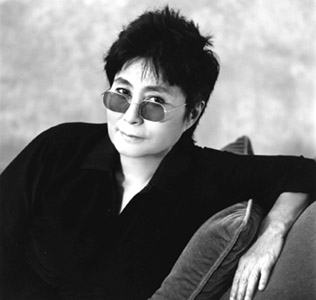![[Metroactive Music]](/music/gifs/music468.gif)
[ Music Index | Silicon Valley | Metroactive Home | Archives ]
 Yoko Ono gets jiggy wid it. Cuckoo for Yoko Her music's puzzling--that's established--but is Yoko Ono's art worth revisiting? By Gina Arnold I WAS WATCHING MTV when I heard the term "bling-blingerati." Someone used it to describe the people at some hip-hop function. Isn't that a great expression? I suppose it means people whose jewelry goes "bling-bling" because there are so many diamonds in it. Yoko Ono is a member of the bling-blingerati--despite a distinct lack of baguettes and naked abs. Yoko's gotten a lot of bad press until recently, but in fact, her story--daughter of a rich Japanese banker reduced to poverty in the rubble of World War II, first female philosophy student at a Japanese University, New York bohemian in the late '50s and early '60s, wife of the murdered Beatle--is as compelling as they come. She dresses austerely, in black and white, but her absolute celebrity cannot be denied. It's difficult to figure out where her celebrity ends and her artistry begins, but San Francisco MOMA, which is currently exhibiting a retrospective of her work called "Yes," is making the attempt. It is the perfect show for today's burgeoning museum industry, which seeks to attract new patrons to the art world, since it combines actual cutting-edge contemporary art with an artist whose name is already a household word. Ono is best known for being the wife of John Lennon, but she did have a real career in art before they met in 1966 at a gallery opening in London where Ono was showing some of the work now at MOMA. Reportedly, she didn't know who Lennon was--to him, one of her great attractions. At the time, she was part of an art movement called Fluxus, which emphasized art events or scenes--now known as installations--over static paintings, so most of the work in the show is documentation, rather than actual objects: films of Cut Piece (in which Ono's clothing is cut off her) and Fly (in which flies hover over her naked body, which has been treated with sugar water) and so on. As those works indicate, Fluxus was about concepts rather than art. It was anti-elitist, anti-commercial and wholly experimental, bent on crossing art forms and breaking down the inherent barriers of time and space that bind traditional art to galleries and even walls. One of Ono's contributions to Fluxus in the early '60s was her art "scores," which were enacted by the artist and then "performed" by the viewer and artist together--a play on the Duchampian idea that art is only partly created by the artist and then completed by the spectator. That may sound airy-fairy, but if you think about it, it was prescient. Today, almost everything creative is also interactive: DVDs, CD-ROMs, Gameboys, multimedia presentations, file-sharing, and so on. Although Ono was quite an important figure in the international avant-garde of the '60s, her marriage to Lennon finished her off as a persona in her own right. These days, it's impossible to extricate Ono's public image from her art--and even more impossible to say whether her art is good. Even at the time, its main attribute was its impact, rather than its beauty. In some ways, however, her ideas have been more lasting and less dated than one cares to admit. Take Apple, a piece that consists of a real green apple placed on a table in front of a white background. Apple is meant to remind the viewer of Adam and Eve, evil and wisdom, growth and decay; of course, it's also the type of thing that makes people crazy--being a leading contender in the "my kid could do that" school of art. Apple's simplicity is almost monstrous in its conceit, and yet the idea of a decomposing object being a changing work of art remains vibrant and valid--and has been reused by artists like Damian Hirst and others, over and over again. Ono's music is equally puzzling--simultaneously unlistenable and influential. Of course, her real impact on the world has been more personal: she is credited with breaking up the Beatles, and although I think that's a load of crap and would have happened anyway, she certainly did have some impact on Lennon's subsequent work and peace activism. With the world unfortunately at war again, Yoko Ono's life and works are ripe for revisiting, which is why a trip to "Yes" is so essential, reminding one of some of the 20th century's most hope-filled ideas. The exhibit runs through Sept. 8.
Send a letter to the editor about this story via email . [ Silicon Valley | Metroactive Home | Archives ]
|
From the July 4-10, 2002 issue of Metro, Silicon Valley's Weekly Newspaper.
Copyright © Metro Publishing Inc. Metroactive is affiliated with the Boulevards Network.
For more information about the San Jose/Silicon Valley area, visit sanjose.com.